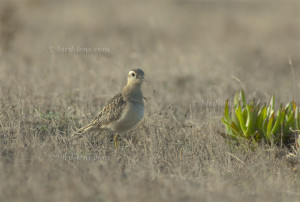 During the fall migration this is one of the areas most visited by ornithologists who want to enjoy the magic of bird Migration in Portugal. One of the birds encountered is the Eurasian Dotterel, among others. The Eurasian dotterel (Charadrius morinellus) is a member of the plover family which migrates from northern Europe, where it breeds, to North Africa, where it winters. A nice place to look for Eurasian Dotterels is in the Algarve. Eurasian Dotterels is a regular passage migrant for many years, mainly in the Sagres Peninsula. The flat fields of Vale Santo are the main area of occurrence of this tundra bird, which likes the steppe. It can be seen there with roughly a 3 weeks delay compared to the german staggering sites every year between September and October.
During the fall migration this is one of the areas most visited by ornithologists who want to enjoy the magic of bird Migration in Portugal. One of the birds encountered is the Eurasian Dotterel, among others. The Eurasian dotterel (Charadrius morinellus) is a member of the plover family which migrates from northern Europe, where it breeds, to North Africa, where it winters. A nice place to look for Eurasian Dotterels is in the Algarve. Eurasian Dotterels is a regular passage migrant for many years, mainly in the Sagres Peninsula. The flat fields of Vale Santo are the main area of occurrence of this tundra bird, which likes the steppe. It can be seen there with roughly a 3 weeks delay compared to the german staggering sites every year between September and October.
The exact screening of suitable areas with binoculars or spotting scope is a must but usually results only with a lot of time and patience in success. Due to the excellent camouflage of the resting birds on a steppe habitat, birds on the ground are much more difficult to detect as migrants which fly over. Once you have discovered a Dotterel, it is relatively easy to determine the ID-characteristics and a Dotterel can hardly be confused with other species. Knowing the vocalizations is extremely helpful. When landing and flying off a trilling call, a melancholy “pjurrr” is often expressed. Eurasian Dotterel rest mainly in groups mostly of this species. Only rarely they mix with other waders (e.g. European Golden-Plover (Pluvialis apricaria)). In a staging area they often behave quite familiar and usually persist even on a few meters distance. To approach them in a car on one of the dirt tracks in the Vale Santo just north of the cape of Sagres might be a good idea. However, larger flocks are sometimes shy and fly away even in case of low interference. The best approach is to get familiar with the calls of the Dotterel, stay in the right location in the right time of the year and to catch birds that call in flight before landing.
Sagres is also a perfect location to look for rarities. Although it is not possible to predict the occurrence of rare birds, because this is the result of many factors – including wind and weather conditions – Sagres have a very good record for this and where some rarities from North America, northern Europe or North Africa occur every year. The high numbers of ornithologists visiting Sagres result consequently in a greater observation effort. This factor, coupled with the fact that this area is a strategic migration point for many birds, makes it unsurprising that rarities are sighted here every year. The places with the most sightings of landbirds are Vale Santo and Monte da Cabranosa. Lagoa do Martinhal and Porto de Sagres are excellent for gulls and waders. The list of vagrants is impressive and include as most recurrent species are Rueppell’s Griffon (Gyps rueppellii) the Lesser Spotted Eagle (Clanga pomarina) and Richard’s Pipit (Anthus richardi).
A good alternative area to look for Eurasian Dotterels in the right time of the year, is in the hilly landscape near Frankfurt. There are many airlines which use the Airport of Frankfurt/ Main, the international hub for Germany. Here you can drive with a rented car in roughly 1 hour to Partenheim and Ober-Hilbersheim close to state capital Mainz.
To cope with the growing demand for top shots of the rarer species of the Palearctic Bird-Lens.com is keen to enrich the range of pictures of birds you can find in the western palearctic. Trips to productive locations in Germany but also to remote places in the world to capture images of rare birds of western palearctic were very successful. The nice image of the blog was shot in the Sagres Peninsula and is only a first impression, what you will find in the gallery in the “Picture Shop” very soon. Just give a message, if bird-lens.com could serve you with an image needed before the new pictures are online.